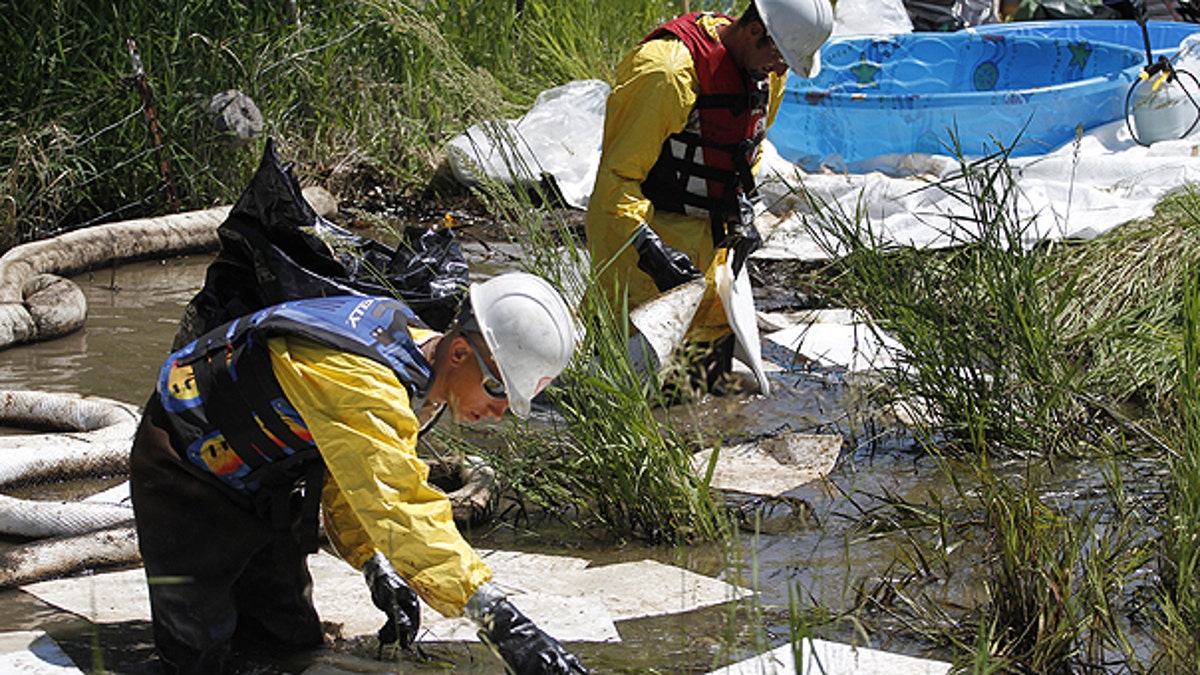
July 5: Cleanup crews work to clear oil from along side the Yellowstone River in Laurel, Mont. (AP)
LAUREL, Mont. – Federal documents show it took Exxon Mobil nearly twice as long as it publicly disclosed to fully seal a pipeline that spilled roughly 1,000 barrels of crude oil into the Yellowstone River.
Details about the company's response to the Montana pipeline burst emerged late Tuesday as the Department of Transportation ordered the company bury the duct deeper beneath the riverbed, where it is buried 5 to 8 feet underground to deliver 40,000 barrels of oil a day to a refinery in Billings.
The federal agency's records indicate the pipeline was not fully shut down for 56 minutes after the break occurred Friday near Laurel. That's longer than the 30 minutes that company officials claimed Tuesday in a briefing with federal officials and Gov. Brian Schweitzer.
An Exxon Mobil spokesman said the longer time span was based on information provided to the agency by the company and the discrepancy might have come about because Exxon Mobil Pipeline Co. President Gary Pruessing was speaking without any notes in front of him when he addressed Schweitzer.
"Clearly our communication with the regulator (DOT) is the one that we've got precision on," spokesman Alan Jeffers said.
It was not the first time the company offered clarification of its response and assessment of the spill. A day earlier, the company acknowledged under political pressure that the leak's impact could extend far beyond a 10-mile stretch of the river it initially said was the most affected area. The company had earlier downplayed government officials' assertions that damage was spread over dozens of miles.
The governor toured the area Tuesday as the waterway rose above flood stage and stoked fears that surging currents could push crude into undamaged areas and back channels vital to the river's prized fishery. Conditions have hampered efforts to find the cause of the break.
The river has been flowing too swiftly for crews to reach some oiled areas, and forecasters said mountain snowmelt was adding to high water levels. Officials speculated that the surge may push oil into areas that haven't yet been damaged.
Most observations have been made through aerial flights.
A few miles downriver from the broken pipe, homeowner Robert Castleberry said he had been out of his house since Saturday because of dangerous fumes from oil that the river pushed across his yard and into the crawlspace beneath his house.
Castleberry's wife suffers from heart disease and the fumes gave her difficulty breathing, he said. While he appreciated the company promising to cover the couple's immediate expenses, the retired fuel truck driver was doubtful workers would be able to clean up the black, gooey film that laced through the underbrush along the river.
"Exxon's been nothing but 100 percent with us," he said. "But when you get into brush that thick, that's going to be virtually impossible to clean."
Company and federal officials said they have only seen oil about 25 miles downstream from the site of the break near Laurel. But Schweitzer said he believes some has traveled hundreds of miles to North Dakota.
"At seven miles per hour, some oil is already in North Dakota. That's a given," Schweitzer said. "I'm asking everyone to get out there and report what you see on the river."
Representatives of Exxon Mobil and the Environmental Protection Agency said they had no reports of oil beyond the town of Huntley.
Transportation officials said Tuesday that oil was observed as far downstream as 240 miles in Terry, Mont. The agency said that information was provided by Exxon Mobil, but company spokesman Alan Jeffers said he was not aware of any such sighting.
Exxon planned to test the river's conditions with a jet boat, with eight more on standby if the launch is successful, Glass said.
Federal regulators have ordered Exxon to make safety improvements to the 20-year-old pipeline. Among them was an order to re-bury the line to protect against external damage and assess risk where it crosses a waterway, which the company intended to comply with, Jeffers said.
"We will follow their requirements," he said.
The company also will have to submit a restart plan to the Department of Transportation before crude can again flow through the line.
Schweitzer also ordered a review of pipelines that cross major and minor rivers in the state. Officials will look at the pipes' age, location of shut-off valves and whether they are similar to the ruptured pipe. He said the state has 88 such crossings.
Modern pipelines can be buried as much as 25 feet beneath bodies of water; Exxon Mobil's Silvertip line was 5 to 8 feet below the bottom of the Yellowstone.
The line was temporarily shut down in May after Laurel officials raised concerns that it could be at risk as the Yellowstone started to rise. The company restarted the line after a day, following a review of its safety record.
Schweitzer said he noticed that oil was pooling in areas near banks with slower-moving water, close to islands and cottonwood stands that support the microbes and insects that bring life to the river.
"Those riparian areas are a biological treasure trove. That's the health and wealth of the river," he said.

